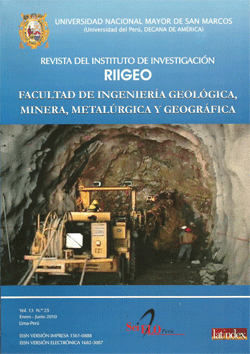Hard rock in situ mining. Its application in a copper oxide ore deposit
DOI:
https://doi.org/10.15381/iigeo.v13i25.388Keywords:
Leaching, in situ, marginal ore, pollution, pumpingAbstract
In situ metalic mining are sistems of metal elements recovery through leaching at their primary emplacements in hard rock ore deposits by appropriate chemical solutions. The methods involve recuperation of metals from ore bodies by circulating solutions through the ore in its undisturbed geologic state and recovering these solutions for processing. In order to attain acceptable orebody permeability for flowing of leach solutions, fragmentation is a basic variable. It should be obtained by drilling and blasting with explosives or by hydrofracturing. Examples are some Southern USA in situ mining operations where rock fragmentation with explosives was succesfully tried in coyote holes or open pit blasting grids. Other significant in situ mining variables are the mineral geologic genesis which works in opposite direction to the insitu leach treatment, the natural rock porosity, the ore left insitu by previous mining exploitation, the unstable rock mass underground, the ore located very deep underground. Costs for gaining this ore are prohibited the only possibility of economic recovery being insitu mining by leach solutions in long hole drilling and conventional mine drives. In this study in situ mining is applied to abandoned oxide copper ore reserves left by the underground mining of a copper ore body which is being exploited for over forty eigth years.
Downloads
Published
Issue
Section
License
Copyright (c) 2010 Oswaldo Ortiz Sánchez, Silverio Godelia Canchari, Carlos A. Soto M.

This work is licensed under a Creative Commons Attribution-NonCommercial-ShareAlike 4.0 International License.
AUTHORS RETAIN THEIR RIGHTS:
a. Authors retain their trade mark rights and patent, and also on any process or procedure described in the article.
b. Authors retain their right to share, copy, distribute, perform and publicly communicate their article (eg, to place their article in an institutional repository or publish it in a book), with an acknowledgment of its initial publication in the Rev. Inst. investig. Fac. minas metal cienc. geogr.
c. Authors retain theirs right to make a subsequent publication of their work, to use the article or any part thereof (eg a compilation of his papers, lecture notes, thesis, or a book), always indicating the source of publication (the originator of the work, journal, volume, number and date).






